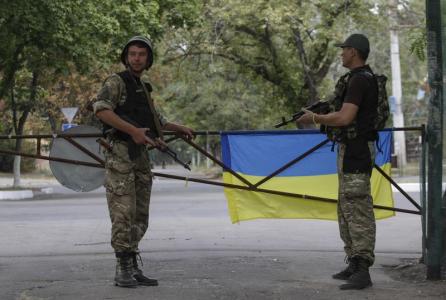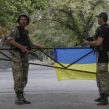
Russian-Speaking Mariupol Says No to Novorossiya
Publication: Eurasia Daily Monitor Volume: 11 Issue: 156
By:

Mariupol illustrates the failure of Russia’s Novorossiya’s project to attract popular support in southeastern Ukraine. That project might have been expected to meet with success in many large cities, including Mariupol. This city of 500,000 (second-largest in the Donetsk province) is thoroughly Russified linguistically, closely linked economically with Russia, and under a municipal administration fully controlled by the Party of Regions, notwithstanding the regime change in Kyiv. Although ethnic Ukrainians slightly outnumber ethnic Russians in Mariupol (49 percent to 44 percent), 89 percent of the city’s population speaks Russian as the everyday language, according to the latest census, which was held in 2001. Such imbalances stem from linguistic Russification of Ukrainians in Tsarist and Soviet times, and would continue under recent “federalization” proposals.
Russia’s paramilitary proxies undertook several attempts from mid-April to mid-May to capture Mariupol. The local police was wavering while government forces were far away. Amid the power vacuum, Metinvest steel company management loyal to Ukraine provided unarmed worker patrols to restore order in Mariupol, undoubtedly on instructions from Metinvest’s main owner Rinat Akhmetov (see accompanying article). This resulted in a temporary situation of dual power in Mariupol, under an informal agreement between loyalist and secessionist forces.
Akhmetov publicly opposed the holding of the May 11 secessionist referendum. This fell flat in Mariupol. Conversely, the May 25 presidential election was held in an orderly manner in this city, albeit on a low turnout. Petro Poroshenko took first place, and the municipal authorities (affiliated with the Party of Regions) announced their support for the president-elect (marsovet.org.ua, May 25, 27). Ukrainian National Guard units entered Mariupol on June 13; and on that date, the Kyiv-appointed state administration of Donetsk province under Governor Serhiy Taruta relocated from the secessionist-controlled Donetsk city to the safe Mariupol. The governor’s own background is also that of a major steel producer in Donbas, with political roots in the Party of Regions.
The Party of Regions was Ukraine’s largest until the fall of President Viktor Yanukovych from power in February 2014. This was basically the party of the industrial and administrative nomenklatura in Ukraine’s south and east; and it has not changed its character, although it has lost parts of its base after the regime change. The Donetsk and Luhansk “people’s republics” have carried out their own regime-changing operation, ousting the Party of Regions from power in the areas under secessionists’ control. If only from vested interests, the Party of Regions (or what remains of it) has opposed Moscow’s “federalization” and Novorossiya projects all along.
Following the double-barreled regime change—in Kyiv and in Donetsk-Luhansk—the Party of Regions has broken up into several groups. Some of these groups have made deals with the new government in the Verkhovna Rada (national parliament) in Kyiv or in certain provinces, cooperating to stabilize the situation (most notably in Kharkiv). Some offshoots from the Party of Regions plan to run in the parliamentary elections, scheduled to be held on October 26. Rebranded, they hope to retain at least some of their traditional voters in Ukraine’s south and east. This has perhaps the most direct bearing on the Donetsk province with Mariupol.
Top managers of Rinat Akhmetov’s enterprises have most recently launched the Industrial Party. This seems to be the most top-heavy among the old Party of Regions’ offshoots. Industrial Party leaders include chief executives of the Mariupol-based Azovstal and Ilyich steelworks (see above) and other industrial CEOs from Donetsk and neighboring provinces. Akhmetov’s closest political associate, Borys Kolesnikov, a Mariupol native and former Party of Regions chairman, is an organizer of the new Industrial Party (Interfax-Ukraine, August 26; Kyiv Post, September 1).
Russian regular forces threatened to attack Mariupol between August 26 and September 5 (see accompanying article). This threat strengthened the resolve of all pro-Ukraine groups in the city to hold out despite the bleak odds. The National Guard’s Azov battalion, industrial enterprises, city police, and the municipal administration (solidly Party of Regions), all executed their appointed tasks under plans prepared by governor Taruta’s office and a crisis staff. Municipal authorities organized pro-Ukraine rallies in the city and appealed for volunteers to undergo paramilitary training. Hundreds registered. Mariupol’s RadioTV (Metinvest-controlled) and the municipality’s website mobilized support for holding out (marsovet.org.ua, Ukrinform, August 27–September 7).
Isolated from the main Ukrainian forces, and with the overall situation developing in Russia’s favor in Donbas, Mariupol could only have resisted a short time. The defense preparations and the Azov battalion’s holding actions on the city’s outskirts did gain the necessary time until the September 5 armistice.




